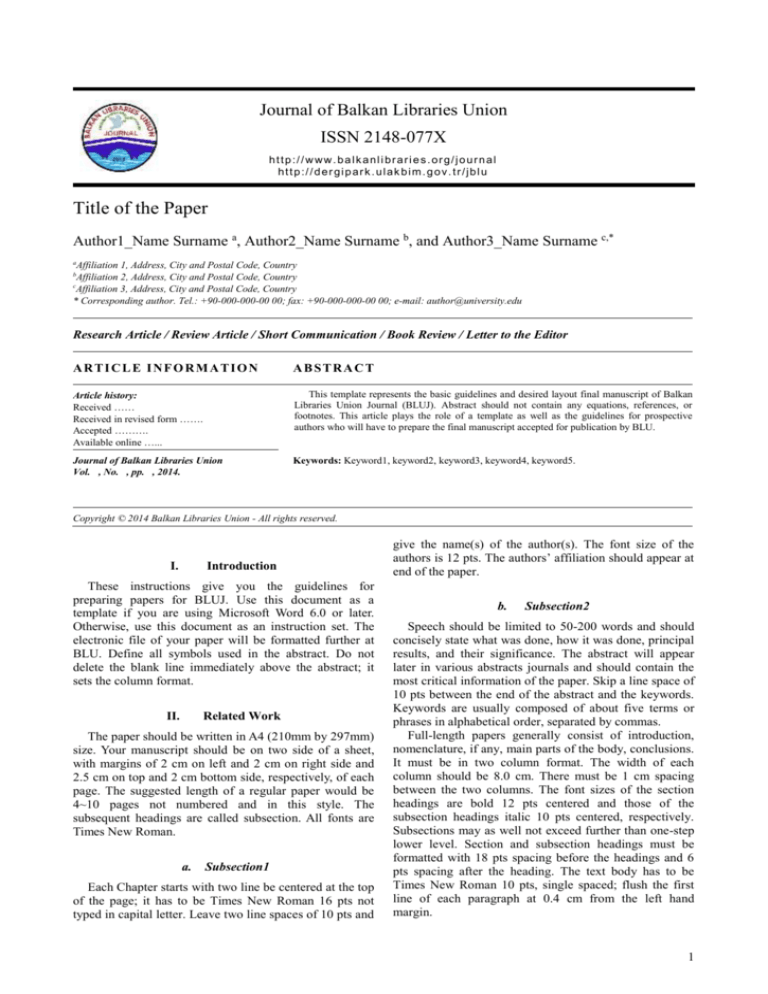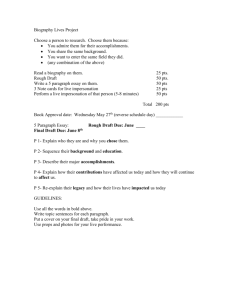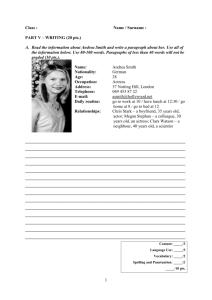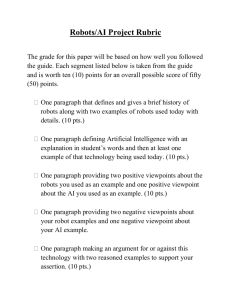
Journal of Balkan Libraries Union
ISSN 2148-077X
http://www.balkanlibraries.org/journal
http://dergipark.ulak bim.gov.tr/jblu
Title of the Paper
Author1_Name Surname a, Author2_Name Surname b, and Author3_Name Surname c,*
a
Affiliation 1, Address, City and Postal Code, Country
Affiliation 2, Address, City and Postal Code, Country
c
Affiliation 3, Address, City and Postal Code, Country
* Corresponding author. Tel.: +90-000-000-00 00; fax: +90-000-000-00 00; e-mail: author@university.edu
b
Research Article / Review Article / Short Communication / Book Review / Letter to the Editor
ARTICLE INFORMATION
ABSTRACT
Article history:
Received ……
Received in revised form …….
Accepted ……….
Available online …...
This template represents the basic guidelines and desired layout final manuscript of Balkan
Libraries Union Journal (BLUJ). Abstract should not contain any equations, references, or
footnotes. This article plays the role of a template as well as the guidelines for prospective
authors who will have to prepare the final manuscript accepted for publication by BLU.
Journal of Balkan Libraries Union
Vol. , No. , pp. , 2014.
Keywords: Keyword1, keyword2, keyword3, keyword4, keyword5.
Copyright © 2014 Balkan Libraries Union - All rights reserved.
I.
Introduction
These instructions give you the guidelines for
preparing papers for BLUJ. Use this document as a
template if you are using Microsoft Word 6.0 or later.
Otherwise, use this document as an instruction set. The
electronic file of your paper will be formatted further at
BLU. Define all symbols used in the abstract. Do not
delete the blank line immediately above the abstract; it
sets the column format.
II.
Related Work
The paper should be written in A4 (210mm by 297mm)
size. Your manuscript should be on two side of a sheet,
with margins of 2 cm on left and 2 cm on right side and
2.5 cm on top and 2 cm bottom side, respectively, of each
page. The suggested length of a regular paper would be
4~10 pages not numbered and in this style. The
subsequent headings are called subsection. All fonts are
Times New Roman.
a.
Subsection1
Each Chapter starts with two line be centered at the top
of the page; it has to be Times New Roman 16 pts not
typed in capital letter. Leave two line spaces of 10 pts and
give the name(s) of the author(s). The font size of the
authors is 12 pts. The authors’ affiliation should appear at
end of the paper.
b.
Subsection2
Speech should be limited to 50-200 words and should
concisely state what was done, how it was done, principal
results, and their significance. The abstract will appear
later in various abstracts journals and should contain the
most critical information of the paper. Skip a line space of
10 pts between the end of the abstract and the keywords.
Keywords are usually composed of about five terms or
phrases in alphabetical order, separated by commas.
Full-length papers generally consist of introduction,
nomenclature, if any, main parts of the body, conclusions.
It must be in two column format. The width of each
column should be 8.0 cm. There must be 1 cm spacing
between the two columns. The font sizes of the section
headings are bold 12 pts centered and those of the
subsection headings italic 10 pts centered, respectively.
Subsections may as well not exceed further than one-step
lower level. Section and subsection headings must be
formatted with 18 pts spacing before the headings and 6
pts spacing after the heading. The text body has to be
Times New Roman 10 pts, single spaced; flush the first
line of each paragraph at 0.4 cm from the left hand
margin.
1
Journal of Balkan Libraries Union
As for the fonts and the sizes of the headings, this
manuscript in itself constitutes a good example.
III.
Tables and Figures
Please insert your figures with “inline wrapping” text
style, as in this template (see Fig. 1).
Please do not use colors in the figures unless it is
necessary for the proper interpretation of your figures.
Place figure captions below the figures; place table titles
above the tables. Tables and figures must be centered.
Large figures and tables may span both columns. If your
figure has two parts, include the labels “(a)” and “(b)”.
Letters in the figure should be large enough to be readily
legible when the drawing is reduced. Do not forget to
include the label, unit for each axis and the legend when
they are required. Use the abbreviation “Fig.” even at the
beginning of a sentence. Do not abbreviate “Table.”
Tables are numbered with Roman numerals. Please do not
include captions as part of the figures. Do not put captions
in “text boxes” linked to the figures. Do not put borders
around the outside of your figures. Do not use color for
the proper interpretation of your figures. The title of the
Table must be centered; it has to be 8 pt typed in capital
letter. Leave one line space of 10 pt after the Table.
TABLE I
SPECIFICATIONS ADOPTED FOR THE SIMULATED INVERTER
Part name/
Manufacturer
mty100n10e
S1,2
(ONS)
irfpc50
Sa
(IR)
30cpq150
D1,2
(IR)
hfa15tb60
D3,4,5,6,7,8,9
(IR)
ETD49 – 3c6a
Tr
ferrite type
(Philips)
Primary inductor
L1 , L2
(Philips)
No vertical lines in table.
Components
Rating values
100 V – 100 A – 11 m
IV.
Abbreviation and Acronyms
Abbreviation and acronyms should be defined the first
time they appear in the text, even after the have already
been defined in the abstract. Do not use abbreviations in
the title unless they are unavoidable.
V.
Units
It is strongly encouraged that the authors may use SI
(International System of Units) units only.
VI.
Equations
Equations should be placed at the center of the line and
provided consecutively with equation numbers in
parentheses flushed to the right margin, as in (1). You
must use Microsoft Equation Editor or Mathtype. Be sure
that the symbols used in your equation have been defined
before the equation appears or immediately following.
vref t
-
(1 H )3
r 1
X k nk 2Vr sin t
(1)
The equations must be the following sizes:
Full text
10 pt
Subscript/Superscript
7 pt
Sub-Subscript/superscript
5 pt
Symbol
16 pt
Sub-Symbol 8 pt
The style of the text is Times new Roman.
600 V – 11 A – 600 m
150 V – 30 A – 0.78 V
600 V – 15 A – 1.7 V
Np:Ns = 6:36
680 H
VII.
Conclusion
Even though a conclusion may review the main results
or contributions of the paper, do not duplicate the abstract
or the introduction. For a conclusion, you might elaborate
on the importance of the work or suggest the potential
applications and extensions.
Appendix
Appendixes, if
acknowledgment.
needed,
appear
before
the
Acknowledgements
This work was supported by BLU.
References
Fig. 1. Turn-on and turn-off of the Sr switch
Figure caption must be 8 pt. Leave one line space of 10
pts after the figure caption.
A reference list is a list of all sources consulted when
researching a chapter. A list of works cited in your
contribution is a subset of the reference list, and includes
only those sources actually cited in the body of the text
and we refer to this as a list of references. We would ask
you to use the APA system for references. Please look at
the following web pages for information about APA style.
http://www.citefast.com/styleguide.php?style=APA&sec=
webp
2
Journal of Balkan Libraries Union
https://owl.english.purdue.edu/owl/resource/560/05/
Please ensure that the reference in the text and in the
list of references tallies in details such as spelling of the
author’s name, etc. Please do not cite any websites that
are editable by the general public, for example
Wikipedia/Wikimedia or the online versions of
encyclopedias such as The Encyclopedia Britannica, as a
reference or source. It is not possible to trace the sources
of information on these websites and they therefore lack
the necessary scientific credibility for use in a scientific
publication.
Footnotes
Footnotes can be used to provide source references
where there are so few as not to warrant numbered lists at
the end of each chapter. Discursive footnotes should be
avoided wherever possible by incorporating the material
into the main text (or omitting it altogether). Do not use
automatic footnote facilities provided by word processing
packages.
Author1_Name Surname The authors may
include biographies at the end of regular papers.
The first paragraph may contain a place and/or
date of birth (list place, then date). Next, the
author’s educational background is listed: type
of degree in what field, which institution, city,
state or country, and year degree was earned.
The author’s major field of study should be
lower-cased. The second paragraph uses the
pronoun of the person (he or she) and not the
author’s last name. Information concerning
previous publications may be included. Current
and previous research interests ends the
paragraph. The third paragraph begins with the
author’s title and last name (e.g., Dr. Smith,
Prof. Jones, Mr. Kajor, Ms. Hunter). List any
memberships in professional societies. The
photograph is placed at the top left of the
biography. Personal hobbies will be deleted
from the biography.
Author2_Name Surname The authors may
include biographies at the end of regular papers.
The first paragraph may contain a place and/or
date of birth (list place, then date). Next, the
author’s educational background is listed: type
of degree in what field, which institution, city,
state or country, and year degree was earned.
The author’s major field of study should be
lower-cased. The second paragraph uses the
pronoun of the person (he or she) and not the
author’s last name. Information concerning
previous publications may be included.
3









